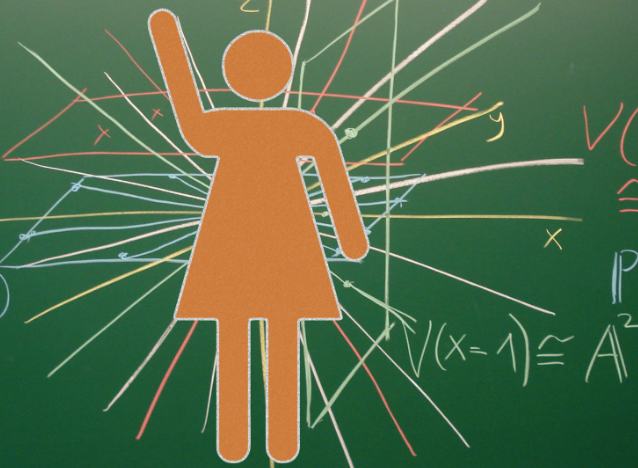You have /5 articles left.
Sign up for a free account or log in.

Wikimedia Commons
A 2018 study finding a “gender-equality paradox” in science, technology, engineering and math was controversial for obvious reasons: if there is an inverse relationship between how egalitarian a society is and how many of its women pursue STEM degrees, as the paper suggested, then maybe efforts to push girls and women into these fields are pointless.
Two years later, the study is still in dispute. And a pair of commentaries published this week in Psychological Science doesn’t seem likely to settle this particular sex-difference question.
“Women in science have been pushing back the tide of claims about women’s lack of interest and ability in STEM for decades,” reads a write-up of one of those commentaries by two of its co-authors, published in Slate. The authors, Meredith Reiches, assistant professor of anthropology at the University of Massachusetts at Boston, and Sarah S. Richardson, professor of the history of science and studies of women, gender and sexuality at Harvard University, added, “The work continues today. As we see it, the so-called gender equality paradox is a new entry in an old playbook of arguing that biological sex differences, not social inequalities, drive the gender disparities we see in areas such as STEM.”
“A little digging,” they said, “shows that the paradox is the product not of innate sex differences in STEM interest, but the use of contrived measures and selective data to tell a particular story.”
By a “little digging,” Reiches and Richardson were referring to the work they did to challenge the 2018 “paradox” paper, which was written by David C. Geary, Curators’ Professor of Psychological Sciences at the University of Missouri at Columbia, and Gijsbert Stoet, professor of psychology at the University of Essex in Britain.
Geary and Stoet analyzed international data on adolescent achievement and found that girls performed similarly to or better than boys in science in two of every three countries, and that in nearly all countries studied, more girls “appeared capable of college-level STEM study than had enrolled.” The gap between boys’ science achievement and girls’ reading achievement relative to their average academic performance was “near universal,” the pair also found, and “these sex differences in academic strengths and attitudes toward science correlated with the STEM graduation gap.”
"Paradoxically,” they said, “the sex differences in the magnitude of relative academic strengths and pursuit of STEM degrees rose with increases in national gender equality.”
An advanced analysis suggested that “life-quality pressures in less gender-equal countries promote girls’ and women’s engagement with STEM subjects.”
In other words, a desire for equality -- not innate interest -- drives women toward STEM where women are considered less equal. Where women enjoy relative equality, they are less motivated to study STEM. So all things being equal, women are less interested in studying STEM.
As the study caught media and other public attention, and because it conflicted with much of their own research about historical biases and other barriers against women in STEM, Reiches, Richardson and their colleagues at Harvard’s GenderSci Lab looked into the numbers.
As Reiches and Richardson wrote in Slate, they tried the replicate the findings. "But their numbers didn’t add up. For example, in Poland, 43.63 percent of STEM graduates are women, which would place it fifth for representation of women in STEM out of the 45 countries included in Stoet and Geary’s analysis. Yet Stoet and Geary reported a value of 26.9 percent, ranking Poland 20th. Why?” Stoet and Geary “weren’t looking at ‘women’s share of STEM degrees,’ as they had claimed, at all.”
Reiches and Richardson highlight the case of Algeria as an example, saying that there, “53 percent of STEM graduates are women. Still, only 9 percent of women college graduates choose a degree in STEM, compared with 13 percent of men. Stoet and Geary had claimed that they were reporting the 53 percent number, but they were actually focusing on the statistic that men were receiving degrees in STEM at a higher rate.”
The publishing journal, Psychological Science, eventually got involved. Geary and Stoet said they’d been using a different measure of representation, but that their results were still valid.
In a 2019 corrigendum, specifically, Geary and Stoet wrote that women graduates throughout their study had been “ambiguously formulated.” They also introduce the concept of women’s and men’s “propensity” to graduate with a college degree in STEM. That “propensity,” they wrote, can be “interpreted as the percentage of women in STEM when equal numbers of men and women enroll at university.”
Reiches and Richardson responded that “propensity” is a flimsy way of updating the aptitude argument that was popular among gender hardliners 20 years ago (e.g., boys are innately better at quantitative work than girls). Moreover, they say, “correlations between women’s STEM degrees and nation-level gender equality don’t stand up when parts of the equation -- how we measure women’s STEM achievement and how we measure gender equality -- are changed.”
Referring to their own commentary in Psychological Science, Reiches and Richardson wrote that “when we tested the correlation between women’s STEM degrees and Stoet and Geary’s own 2019 proposed alternative gender-equality index, a separate index that includes basic measures of well-being such as health, education, and life satisfaction, there was no paradox to be found.”
They further cautioned against using national-level data such as the World Economic Forum’s Global Gender Gap Index as a measure of gender equality. For instance, they said, Rwanda ranked sixth in the world on the 2015 index due to high representation of women in economic and political life. But that is more a reflection of post-genocide sex ratio imbalances than any campaign to increase women’s empowerment.
Call and Response
Geary said Thursday via email that his original data were not misleading, despite the correction. In any case, he said, “We focused on the expectancy-value theory, whereby people make educational and occupational choices based on their relative strengths (e.g., whether they are relatively better in reading than math, independent of absolute performance) and interests.”
Accordingly, he continued, “we focused on the percent of all women (and men) who go into STEM and its relation to their academic strengths and interests, as we explain in our clarification.”
Geary also said that he and Stoet “focused on inorganic STEM fields (e.g., computer science) because this is the focus of much debate.” Looking at STEM broadly, he said, including the life sciences, “the balance of men and women is more equal, because many science-oriented women are pursuing careers in the life sciences (e.g., medicine).”
The 2018 study notes that women are underrepresented in inorganic fields. But it says it considered UNESCO data from 2012 to 2015 on graduates in the natural sciences, mathematics, statistics, information and communication technologies, engineering, manufacturing and construction. And UNESCO considers the life sciences to be part of the natural sciences.
In any case, the study cites Finland, for example, which “excels in gender equality,” and where “adolescent girls outperform boys in science literacy” and students perform well over all.
“With these high levels of educational performance and overall gender equality,” the paper says, “Finland is poised to close the STEM gender gap. Yet, paradoxically, Finland has one of the world’s largest gender gaps in college degrees in STEM fields, and Norway and Sweden, also leading in gender-equality rankings, are not far behind,” with fewer than 25 percent of STEM graduates being women.
Geary and Stoet don’t back down in their reply to the GenderSci lab’s commentary (again, both commentaries were published this week in Psychological Science).
“We hypothesize that men are more likely than women to enter STEM careers because of endogenous interests,” Geary and Stoet wrote. “Societal conditions can change the degree to which exogenous interests influence STEM careers (e.g., the possibilities of STEM careers to satisfy socio-economic needs). But when there is an equal playing field and studying STEM is just as useful (balancing income and career satisfaction) as a degree in other areas, people are better able to pursue their interests and not simply their future economic needs.”
This means then “that the relatively large sex differences in occupational interests become more clearly expressed in countries where occupational choices are less constrained by the financial incentives to study a STEM subject. We are optimistic that future studies will help to confirm or reject such a theoretical account.”
As Richardson, Reiches and their team touch on in their critiques, the term “endogenous interests” is loaded in itself. That is, it’s nearly impossible to determine what preferences are truly innate versus shaped by even subtle external forces.
A recent study, for example, found that even men and women who have the same sorts of priorities regarding field of study tend to choose different majors. Specifically, men’s choices in major were linked to higher-paying prospective jobs: men who prioritized wanting to help people via their majors, for instance, were more likely to choose biology, a premedicine field, whereas women who wanted to help people were more likely to choose nursing.
The study theorized that efforts to engage women in certain fields may not work until their cultures become more welcoming and thus change women’s expectations about what jobs are truly open to them.
The author of that study, Natasha Quadlin, an assistant professor of sociology at Ohio State University, said the debate is much more complicated than women being “less interested” in STEM than men.
“My research, and many other social scientists’ research, shows that women face many more barriers than men when it comes to STEM majors and careers,” she said, “from subtle messages that women are not capable of performing in STEM, to expectations that they will face barriers in the workplace.”
Put another way, said Quadlin, “it’s not really that women are uninterested in STEM -- they may just be uninterested in the challenges STEM may impose in their broader lives.”









.jpg?itok=sZ1Pn-fP)